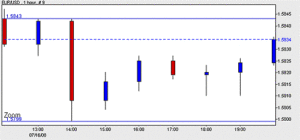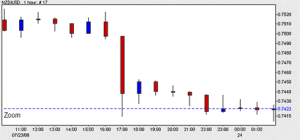Why interest rates matter for forex trading
The biggest factor affecting the currency market is interest rate changes made by any of the global central banks, which have a major impact on currency trading. These changes are an indirect response to other economic indicators observed throughout the month, and they could potentially move the market immediately and with full force. Since surprise changes often have the greatest impact on traders, understanding how to predict and react to these volatile movements can lead to higher profits.
Forex markets track how different currency pairs fluctuate
One of the main factors affecting these exchange rates is relative differences in interest rates in each country. While interest rates can often be predicted using economic models, news and surprise announcements can have immediate effects on interest rates, which in turn affect exchange rates.
Bases for interest
Interest rates are crucial in the foreign exchange market because the higher the yield, the more interest is charged on invested currency and the higher the profit. This is called Carry Trade.
Of course, the risk in this strategy is currency fluctuations, which can dramatically offset any interest-bearing rewards. While you may always want to buy currencies with higher interest rates (financing them with those with lower interest rates), such an action is not always wise. Interest rates should be viewed with a cautious eye, as should any news announcements on interest rates from central banks.
How is interest calculated?
Each central bank board controls the country’s monetary policy and the short-term interest rate at which banks can borrow from each other. Central banks will raise interest rates to contain inflation and lower interest rates to encourage lending and spread money around the economy.
Usually, you can have a strong insight into what a bank will decide by reviewing the most relevant economic indicators, namely:
- Consumer price index (CPI)
- Consumption
- Employment levels
- The subprime market
- The housing market
Predicting central bank interest rates
Armed with data from these indicators, a currency trader can make their own estimate for a price change. When these indicators improve, the economy will normally perform well and interest rates will either have to be raised or, if the improvement is small, kept the same. On the same note, significant decreases in these indicators could reduce an interest rate cut to encourage borrowing.
Outside of economic indicators, it is possible to predict an interest rate decision:
- View larger messages
- Analyzing forecasts
- Major announcements
Major announcements by central bankers tend to play an important role in interest rate changes. But they are often overlooked in response to economic indicators. When a board from any of the eight major central banks is scheduled to speak publicly, it will usually provide insights into how the bank views inflation.
For example, on July 16, 2008, Federal Reserve Chairman Ben Bernanke gave his semi-annual monetary policy testimony before the House Committee. At a normal meeting, Bernanke would read a prepared statement on the value of the US dollar and answer questions from committee members.
In his statement and response, Bernanke considered that the US dollar was in good shape and that the government was determined to stabilize it even though fears of a recession were affecting all other markets.
The statement was followed by the financial market and currency traders and as it was positive, traders expected the Federal Reserve to raise interest rates, causing a short-term rally in the dollar in preparation for the next interest rate decision.

Figure 1: The EUR/USD currency pair falls in response to the Fed’s monetary policy testimony.
The EUR/USD currency pair fell 44 pips in one hour (good for the US dollar), resulting in a $440 gain for traders who acted on the message.
Forecast analysis
The second way to predict interest rate decisions is by analyzing predictions. Since interest rate changes are usually expected, brokers, banks and professional traders will already have a consensus estimate of what the interest rate will be.
Traders can take four or five of these forecasts (which should be very close numerically) and average them for a more accurate prediction.
When a surprise change occurs
No matter how well a trader has done their homework, or how good the analysis is, or how many numbers they have crunched before making an interest rate decision, central banks can deliver a surprise message, an interest rate can be unexpectedly cut or raised.
When this happens, a trader should know the direction in which the market will move. If there is a rate hike, the currency will rise, meaning traders will buy. If there is a decrease, sellers will probably sell and buy currencies with higher interest rates. Once a trader has determined the market movement, it is important to do the following:
Act quickly! The market tends to move quickly when a surprise hits as all traders aim to buy or sell (depending on a rate hike or cut) ahead of the pack. Quick action can lead to a significant gain if done correctly.
Watch out for a volatile trend reversal. A trader’s perception tends to guide the market at the first publication of data, but the trend is likely to continue on its original path.
The following example illustrates the above steps in practice
In early July 2008, the Reserve Bank of New Zealand had an interest rate of 8.25% – one of the highest among central banks. The exchange rate of the New Zealand dollar had been stable for the past four months as it was a hot currency that currency traders liked to buy because of its higher yield.
In July, against all predictions, the bank’s board of directors cut the rate to 8 percent at its monthly meeting. While the drop in the quarter seems small, currency traders took it as a sign of the bank’s fear of inflation and immediately withdrew their capital or sold the currency and bought others – even if the others had lower interest rates.

Figure 2: The NZD/USD currency pair falls in response to an interest rate cut by the Bank of New Zealand.
The NZD/USD currency pair dropped from .7497 to .7414, a total of 83 pips in five to ten minutes. Those who sold just one ticket of the currency pair made a net profit of $833 in just a few minutes.
As quickly as NZD/USD degenerated, it didn’t take long for it to get back on track with its uptrend. The reason it did not continue the free fall was that, despite the rate cut, the NZD still had a higher interest rate, eight percent, than most other currencies.
It is important to read through an actual central bank press release (after determining whether there has been a surprise rate change) to determine how the bank views future interest rate decisions. The data in the release will often induce a new trend in the currency after the short-term effects have taken place.
Following the news and analyzing central bank actions should be a top priority for forex traders. When banks determine their country’s monetary policy, exchange rates tend to move. When exchange rates move, traders have the opportunity to maximize profits – not only through interest transfer from carry trades, but also from actual fluctuations in the market. Thorough analysis can help a forex trader avoid surprise interest rates and react to them properly when they inevitably happen.
About the Viking
With Viking’s signals, you have a good chance of finding the winners and selling in time. There are many securities. With Viking’s autopilots or tables, you can sort out the most interesting ETFs, stocks, options, warrants, funds, etc.
Click here to see what Vikingen offers: Detailed comparison – Stock market program for those who want to become even richer (vikingen.se)













